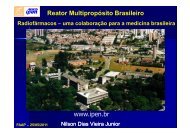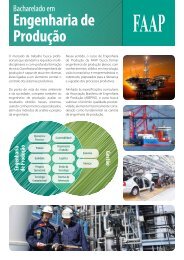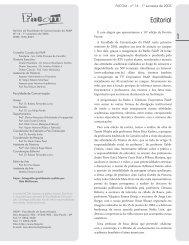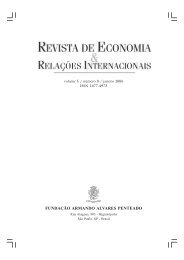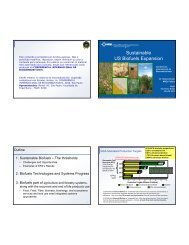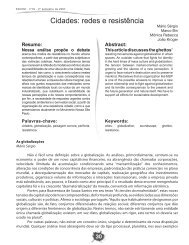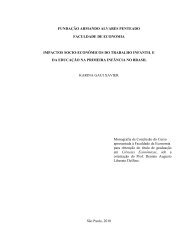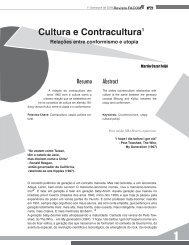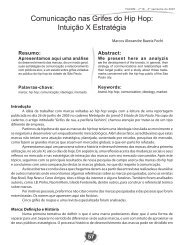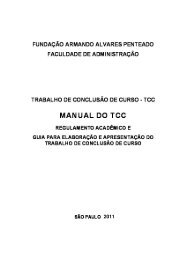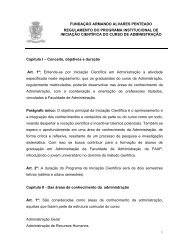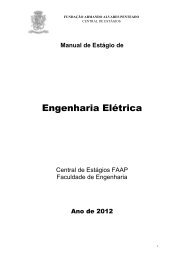Guia de Estudos - Faap
Guia de Estudos - Faap
Guia de Estudos - Faap
Create successful ePaper yourself
Turn your PDF publications into a flip-book with our unique Google optimized e-Paper software.
<strong>Guia</strong> <strong>de</strong> <strong>Estudos</strong> / Study Gui<strong>de</strong> / <strong>Guia</strong> <strong>de</strong> Estudios<br />
Américan Continent<br />
The Canadian diamond industry is <strong>de</strong>veloping itself<br />
into a prominent one, hence, the country’s vast interest<br />
in the subject, “by 2003, Canada had become the<br />
world’s third largest diamond producer on a value basis<br />
after Botswana and Russia.” Even though Canada is<br />
not a member of this committee, it is a great example<br />
of a country that supports the proposals established<br />
by the Kimberley Process as it has had a leading role<br />
in the implementation of its measures and is a country<br />
that has been important when it comes to the issues.<br />
The Unites States of América (USA) is also part to<br />
the Kimberley Process, helping the African Continent,<br />
and adopting measures to end the issue. The country<br />
is responsible for one third of the global diamond<br />
sales and because of this fact, the USA gained a lea<strong>de</strong>r<br />
position in the search for methods to avoid conflicts<br />
financed by illicit diamonds.<br />
An important and interesting fact about the USA<br />
is that its embassy, managed a training workshop<br />
to enhance the ability of the officers that monitored<br />
the mines in Sierra Leone, towards tackling diamond<br />
smuggling. This was a great contribution from the<br />
country, as an attempt to reach a solution for the<br />
smuggling problem. That can be seen at the statement<br />
by Ambassador Rosemary A. DiCarlo, also U.S. Deputy<br />
Permanent Representative to the United Nations at an<br />
Open Security Council Debate on the United Nation’s<br />
Counter Terrorism Committees on November 15th of<br />
2010, where it says:<br />
The United States welcomes the significant enhancements<br />
to the regime’s listing and <strong>de</strong>listing processes outlined<br />
in Resolutions 1735, 1822, and 1904. We remain<br />
confi<strong>de</strong>nt that the establishment of an in<strong>de</strong>pen<strong>de</strong>nt<br />
Ombudsperson for the regime will help ensure that the<br />
<strong>de</strong>listing procedures are fair and transparent. We welcome<br />
Kimberly Prost’s appointment as the Committee’s first Ombudsperson,<br />
and we look forward to working with her.<br />
Brazil is not a country that has a significant participation<br />
in the trading of conflict diamonds originated<br />
in Africa. In its own territory, however, the country has<br />
to <strong>de</strong>al with issues of the same matter. In Cinta Larga,<br />
Brazil’s indigenous tribe reservation, due to the country’s<br />
rich diamond mines, illicit diamond trading takes<br />
place. Mining these lands is illegal, but a “black mar-<br />
ket” has existed since the late 1900’s.<br />
In Africa, conflict diamonds have financed and exten<strong>de</strong>d<br />
wars in the continent; in Colombia, cocaine has<br />
supported the conflicts in the country. The two major<br />
guerrilla groups, the Revolutionary Armed Forces of Colombia<br />
(FARC) and the National Liberation Army (ELN) are<br />
playing and expanding spot in the cocaine´s productions.<br />
Just like the “blood diamond” smuggling, the drug traffic<br />
is also in the black market and these problems affect very<br />
much the countries they are related to. Therefore Colombia<br />
must have support from its neighbors:<br />
The Colombian experience confirms that only by achieving<br />
a balance between the actions aimed at <strong>de</strong>creasing the supply<br />
and <strong>de</strong>mand of drugs; it is possible to advance in an efficient<br />
and progressive manner in the fight against the world drug<br />
problem. It is indispensable to face with all the links. All the<br />
countries involved, be it producing, transit, or consumer countries,<br />
must face with equal <strong>de</strong>termination and in a joint manner,<br />
the different manifestations of the problem.<br />
African Continent<br />
Because diamonds are one of the natural resources<br />
that Africa has the most in its territory and it brings along<br />
with conflicts, an astonishing amount of money that helps<br />
the continent <strong>de</strong>velop and gain wealth. Miners produce<br />
billions of dollars worth of diamonds, but earn only a few<br />
per month. However, the money that comes from “blood<br />
diamonds” is used to finance conflicts and terrorist attacks,<br />
jeopardizing the lives of people. There are several<br />
conflicts in the African Continent that happen because of<br />
the so called “blood diamonds”. The faction of the population<br />
that works digging the diamonds can be negatively<br />
affected because the money they earn with this job is<br />
minimum, when compared to the amount of money that<br />
this activity launches as it is known that the industry is<br />
worth billions of dollars.<br />
In the 90’s, there were conflicts in Angola and Sierra<br />
Leone taking place because of “blood diamonds” that financed<br />
the acquisition of weapons. As a consequence,<br />
several lives were taken and a significant number of<br />
people were harmed by the rebels. The rebel group, originated<br />
in Sierra Leone, known as the Revolutionary United<br />
Front (RUF), killed and injured several people who worked<br />
at the diamond mines, until they could fully control these<br />
mines. The group attacked people all around the country,<br />
spreading terror and fear throughout the population. As a<br />
69



